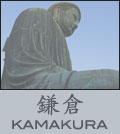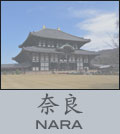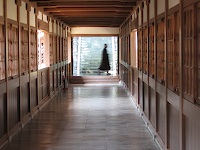Eiheiji
Eiheiji is one of two main temples of the Soto sect of Zen Buddhism, established nearly 800 years ago in what is now known as Fukui Prefecture, northeast of Kyoto. This was my top destination in Japan, the place I most wanted to visit in the whole country. It was up at the top of Vaibhav's list too, so we made a plan to head there towards the end of our trip, on our way back to Tokyo from Kyoto.
Fukui City
On the evening of March 26, we took a train from Kyoto to Fukui City — the capital of Fukui Prefecture, and home of about 250,000 people. What little of it wasn't destroyed by bombing during WW2 was levelled by an earthquake in 1948, and the city has been pretty much completely rebuilt since then, so there's not a lot of traditional architecture to be seen here. There are several shopping streets in the central area around the station, and the station itself is modern and attractive.
We stayed at a hotel next to the main river that runs through the city. From what I've seen in photos, the riverside is quite beautiful at various points throughout the year, particularly during hanami in the spring. We wandered around a little bit in the evening, got some sleep, then headed out the next day to Eiheiji, about 35 minutes outside of the city.
Eiheiji
Eihei Dogen was one of the first to transmit the teachings of Zen Buddhism from China to Japan. Born in Kyoto in 1200, Dogen had lost both of his parents by the time he was seven. At thirteen, he went to Mt. Hiei to seek the teachings of the Buddha, and was officially ordained the following year. But he couldn't find an answer to his deepest question: "If all beings are already buddhas, why do we seek enlightenment?"Dogen was advised to study with the Zen school, which had first been brought to Japan in 1191. His question eventually led him, in 1223, to Song China. He spent two years there in search of a master, and was just about ready to give up when he met Rujing on Tiantong Mountain. Rujing played the most pivotal role in shaping Dogen's life and teachings. Dogen trained under him for two years, received the Dharma transmission, and in 1227 returned to Japan to share his teachings.
The Tendai sect of Buddhism, dominant in Japan at this time, had pressured the existing Rinzai school to present Zen as just one of the four practises of Tendai Buddhism. Dogen, upon his return from China, announced his intention to focus on teaching Zen meditation, and was eventually forced by the Tendai orthodoxy to leave Kyoto. In 1244, he established a monastery in the mountains of Echizen Province (now Fukui), originally known as Daibutsu Monastery but renamed to Eiheiji in 1246. The present day temple was rebuilt in the 15th century.
Dogen died in 1253, leaving behind his heritage as the founder of the Soto sect of Zen and its head temple Eiheiji, where Zen is still actively practised to this day, in the tradition transmitted by Rujing and established by Dogen in Japan.
I was nothing short of inspired by our visit to Eiheiji. Though there are thousands of very beautiful temples in Japan, most of them are hollow echoes of the past. Eiheiji is still very much alive; it's a place where the teachings are still actively practised, and the experience of walking down its ancient halls is quite different.

"To know" and "to understand" are different.
Even though we know, without putting
that knowledge to practise, we cannot understand.
Dogen Zenji





















